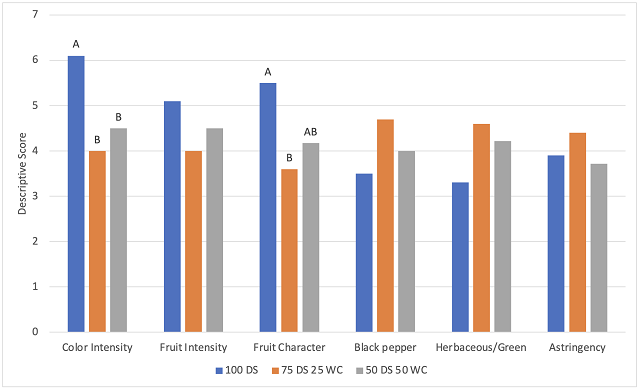Effect of whole cluster inclusion in Virginia Syrah (2022)
Shane McManigle
Doukenie
Summary
The purpose of this experiment was to determine if whole cluster inclusion would increase Syrah varietal character and weight in Doukenie Syrah. There were three treatment levels with 0, 25% and 50% whole cluster inclusion fermented with destemmed fruit. Increased whole cluster inclusion led to decreased alcohol and color and increased pH and acetic acid. Wines produced from 100% destemmed fruit scored the highest for fruit character, indicating dark/black/dried fruit vs. bright/red/fresh fruit character in wines produced with whole cluster inclusion.
Introduction
Syrah is not commonly grown in Virginia, with only 17 tons reportedly harvested from 14 bearing acres in 20221. Syrah is late to break bud, which allows it to avoid most frost events. It ripens rapidly, but the berries shrivel when sugar levels exceed 21-22° Brix. Its shoots can be damaged by wind in early spring and are sensitive to bud necrosis. Vines exhibit vigorous growth, and fruit is susceptible to Botrytis2,3. In regions with ample plantings such as the Rhône and Australia, wines can be high in alcohol with gentle tannins and ample midpalate weight. When underripe, this variety can have flavors of black pepper and burnt rubber. In Virginia, Syrah rarely achieves full ripeness before harvest.
Doukenie is one of the few sites in Virginia growing this variety. In a 2021 WRE experiment at Doukenie, Syrah was co-fermented with (1) 18% Viognier and (2) 18% Tannat. The Syrah-Tannat coferment produced a wine with higher color, tannin, and alcohol and lower pH. This wine also received significantly higher sensory scores for color and fruit character than Syrah alone or the Syrah-Viognier co-ferment. All three of the experimental wines from 2021 were bottled separately. After bottle aging, the Syrah only wine was preferred during in-house testing due to the Syrah-like aromatics and varietal character, as the Tannat components of the co-ferment were seen as taking over the wine. However, the Syrah only wine lacked palate weight.
Syrah varietal character includes descriptors of “black pepper” which is thought to come from rotundone, a sesquiterpene found in skins and stems. Rotundone production is associated with cool growing temperatures, high vigor vines, and ample water availability. Its presence can be highly variable within vineyards, vines, and even bunches, but is generally found in higher concentrations in stems and leaves than grapes4,5. Within grapes, rotundone is produced by skins so extraction depends on skins breaking open during fermentation.
Syrah is often fermented with whole cluster inclusion in its home region, so the impacts of both whole berry fermentation and stem inclusion may be part of the perception of Syrah varietal character. In previous WRE experiments, whole cluster inclusion sometimes led to higher levels of tannin in the wine, which may also help bring weight to this wine.
Whole cluster fermentations are really three fermentations in one, with different chemical processes happening in each6. Grapes that are surrounded by carbon-dioxide rich air generally undergo autofermentation (carbonic maceration) with little extraction from skins and seeds, producing a fruity wine with limited varietal character. Intact grapes surrounded by fermenting must will also undergo carbonic maceration, but to a lesser degree. Alcohol from the surrounding liquid fermentation will eventually break down these skins and limit the tuti-fruity character that often describes fully carbonic wines. Grapes at the bottom of the vessel, and those that burst due to alcohol bathing their skins, undergo a more traditional yeast fermentation with extraction from skins and seeds. If stems are present due to whole cluster inclusion, only those bathed in fermenting liquid will be extracted. To maximize the extractive portion of whole cluster fermentations, it is best to increase the proportion of this third fraction by layering clusters with destemmed fruit, and/or foot stomping the grapes to increase extraction.
(For a more comprehensive guide to whole cluster fermentations, visit the Whole Cluster Fermentation Learn Module on the WRE Website.)
The purpose of this experiment was to determine if whole cluster inclusion would amplify the expression of varietal character in Virginia Syrah. The experiment included three treatment levels plus one demonstration wine:
-
100% destemmed and crushed (100 DS)
-
75% destemmed and crushed, 25% whole cluster (75 DS/25 WC)
-
50% destemmed and crushed, 50% whole cluster (50DS/50WC)
-
100% whole cluster (100 WC)
Methods
Fruit was hand harvested then chilled overnight before processing. For each treatment, 50 mg/L SO2 was added during processing. For the treatments with whole cluster inclusion, clusters were layered in with destemmed fruit without stomping, so some whole berries remained intact. For the 100% whole cluster wine, fruit was stomped as it was added to the bin, leaving few whole berries. This treatment was also fermented in a smaller (½ ton) bin rather than a full TBin. Bins were cold soaked with frequent CO2 gassing for 7 days prior to inoculation. Each of the treatments was inoculated with D254 yeast rehydrated in GoFerm according to the manufacturer’s instructions (Scottlabs). Tartaric acid (2 g/L) was also added at inoculation on 10/5. Once fermentation was underway (on 10/9), all bins were chaptalized with sugar to increase by a target of 2°Brix. Fermentations were relatively cool (reaching 66°F at 10° Brix) and proceeded for 20 days. All bins were drained on the same day, after 6 days of extended maceration. Free run wine was kept separate for the experiment. The press fractions for different treatments were pooled for production efficiency and not included in the experiment. Pressing of the must produced additional sugar, as is expected with whole cluster fermentations. After draining off the must, free run wine completed malolactic fermentation in barrel, then was treated with SO2. Two barrels of wine were produced per bin.
Sensory analysis was completed by a panel of 18 wine producers. Wines were presented blind in randomly numbered glasses. Tasters were presented with three different wines with varying levels of whole cluster versus destemmed and crushed fruit (100% destemmed, 75% destemmed/25% whole cluster and 50% destemmed/50% whole cluster). A fourth wine made from 100% whole cluster fruit was included as a demonstration but not scored due to differences in bin size during fermentation. Tasters were asked to score each wine on a scale of 0 to 10 for color intensity, fruit intensity, fruit character, black pepper, herbaceous/green character and astringency. Fruit character was defined as a range from bright/fresh/red (low scores) to dark/dried/black (high scores). To account for order effects, there were four tasting groups with the order of analysis balanced among groups. Tasters were also given open ended questions to describe the wines. Descriptive scores were analyzed using repeated measures ANOVA. If significant differences were found among scores, Tukey’s test was used to determine which categories were significantly different from one another.
Results
There was a larger crop of Syrah than usual at Doukenie in 2022, with nearly 4 tons harvested in contrast to an expected average of 2.5 tons. The fruit was harvested early to preserve fruit integrity, but with relatively low Brix (Table 1). The variations in fruit chemistry among the three bins may reflect the differences in processing techniques. For example, there is a lower potassium concentration in bins with a higher proportion of whole clusters. Potassium is concentrated in the skins of grapes. A higher level of processing (destemming) is expected to break more berries and lead to higher initial extraction from the skins. Stems also include potassium. Lignification may delay extraction, but lead to overall higher levels of potassium as fermentation continues. Fermentation will also produce alcohol to break down the skins of intact berries, such that chemistry differences due solely to skin vs. pulp ratio will be minimized with time.
Wine chemistry values were measured individually for two barrels of each treatment (Table 2). Alcoholic and malolactic fermentations were completed for all wines leaving undetectable amounts of glucose/fructose and malic acid (data not shown). Sensory analysis was completed using wine from the first barrel listed for each treatment.
Several trends in the chemistry data are consistent with expectations for whole cluster inclusion:
-
Fermentations with a higher proportion of stems produce wine with lower alcohol. Stems contain water and no sugar. This may work counter the winemaking goal of greater palate weight.
-
pH increased with increasing stem inclusion, likely due to the impact of stem potassium. Though bins with a higher proportion of whole cluster fruit had less potassium initially, as fermentation progressed and berries broke down, potassium was eventually released from skins and leached from stems. An increase in potassium is expected to cause a rise in pH due to precipitation of potassium bitartrate.
-
Acetic acid increased with a higher proportion of whole cluster inclusion. Whole clusters contain air pockets providing oxygen to spoilage organisms that can produce acetic acid.
-
Ethyl acetate is often a problem in whole cluster fermentations as well as fermentations with long cold soak due to the presence of Hanseniaspora/Klockera. These microbes come into the winery on the skins of grapes and can proliferate quickly when grapes are crushed and juice is released. They are not well controlled by SO2 and are active even at cold temperatures. Hanseniaspora/Klockera can produce high amounts of ethyl acetate and acetic acid in a short time if oxygen is available. Above the threshold of detection, ethyl acetate is perceived as a flaw, imparting aromas of solvent and nail polish remover. Sub-threshold, this same compound can accentuate fruitiness and increase complexity in wine. In this experiment, ethyl acetate levels in all treatments are very near the threshold of detection and its concentration does not appear to be higher with increasing whole cluster inclusion (Figure 1).
-
Measurement of color intensity by absorbance decreased with increased whole cluster inclusion (Figure 2). The difference in color between wine made with destemmed fruit and whole cluster fruit was significantly different in sensory scores (Table 4). Color is affected by the overall concentration of pigments, the pH of the wine, and the presence of color-stabilizing cofactors. Destemming partially crushes the berries, potentially releasing more anthocyanins, tannins (which stabilize anthocyanins), and cofactors for color stabilization. Stems can absorb anthocyanins and decrease color. There was no clear pattern in anthocyanin concentration based on treatment, though destemming fruit led to higher values for polymeric anthocyanins (Table 3, Figure 3). Color is also affected by pH; higher pH (as seen with increasing stem inclusion) leads to lower color. Hue, a measure of yellowing (420nm:520 nm), also increases with more whole cluster inclusion.
-
One of the main reasons for this study was to determine if the inclusion of whole clusters would lead to increases in tannin, and therefore palate weight. However, the presence of whole clusters in the fermentation can limit tannin extraction from the skins. Here, tannin content decreased with increasing whole cluster inclusion (Table 3, Figure 3). To maximize tannin extraction in whole cluster fermentations, fruit should be thoroughly crushed (stomping works well for TBin sized fermentations). Warmer fermentation temperature would also increase extraction from skins, seeds, and stems.
Sensory
Destemmed Syrah received higher mean scores for color intensity (F=22, P<0.0001)(Table 4) than the other two treatments. Color intensity was not significantly different between the wine made with 25% whole cluster inclusion and 50% whole cluster inclusion (Table 5, Figure 3). Destemmed fruit was also rated significantly higher for fruit character than 75% destemmed/25% whole cluster fruit for fruit character (Tables 4 & 5), shifting ratings toward the dark/dried/black fruit side of the spectrum. Scores for the wine made from 50% destemmed/50% whole cluster fruit received intermediate scores for this attribute (Table 5, Figure 3). There were no significant differences in sensory scores for fruit intensity, black pepper, herbaceous/green character, or astringency (Table 4).
References
(1) 2022 Virginia Commercial Grape Report; Virginia Wine Board, Virginia Vineyards Association, Virginia Wineries Association, 2023.
(2) Wolf, T. K. Wine Grape Production Guide for Eastern North America; Plant and Life Sciences Publishing: Ithaca, New York, 2008.
(3) Robinson, J.; Harding, J.; Vouillamoz, J. Wine Grapes: A Complete Guide to 1368 Vine Varieties, Including Their Origins and Flavours, Illustrated Edition.; The Penguin Group: New York, 2012.
(4) Zhang, P.; Fuentes, S.; Wang, Y.; Deng, R.; Krstic, M.; Herderich, M.; Barlow, E. W. R.; Howell, K. Distribution of Rotundone and Possible Translocation of Related Compounds Amongst Grapevine Tissues in Vitis Vinifera L. Cv. Shiraz. Front. Plant Sci. 2016, 7.
(5) Zhang, P.; Howell, K.; Krstic, M.; Herderich, M.; Barlow, E. W. R.; Fuentes, S. Environmental Factors and Seasonality Affect the Concentration of Rotundone in Vitis Vinifera L. Cv. Shiraz Wine. PLoS ONE 2015, 10 (7), e0133137.
(6) Tesniere, C.; Flanzy, C. Carbonic Maceration Wines: Characteristics and Winemaking Process. Adv. Food Nutr. Res. 2011, 63, 1–15.
Table 1: Juice chemistry for three treatments of Syrah (Vinterra, 9/29)

Table 2: Wine chemistry for four treatments of Syrah (ICV Labs, January & March 2023)

Table 3: Phenolic measures for four treatments of Syrah (mg/L) (ETS labs March 2023)
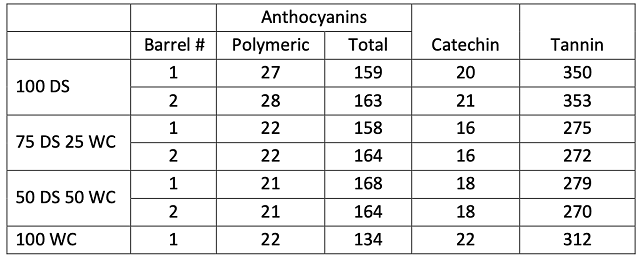
Table 4: Repeated measures ANOVA of descriptive scores from blind sensory analysis of Syrah

Table 5: Tukey’s Test of sensory scores for three treatments of Syrah (XLStat)
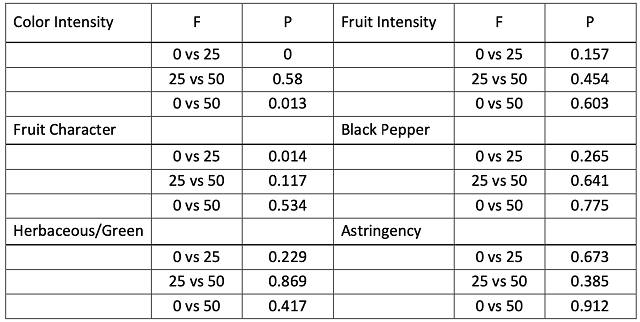
Figure 1: Ethyl Acetate in four treatments of Syrah (ICV labs March 2023) The threshold for detection is between 90 and 150 mg/L (range shown in orange)
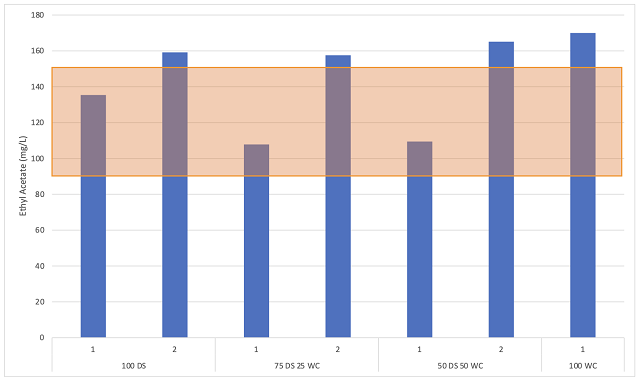
Figure 2: Color Intensity for four treatments of Syrah (ICV labs January 2023) Numbers on endcaps indicate hue (A420/A520)
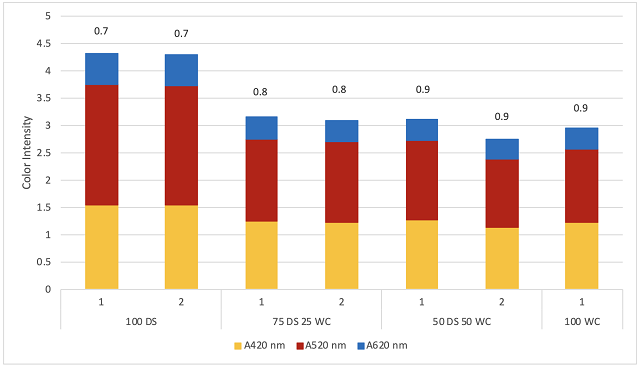
Figure 3: Phenolic measures for four treatments of Syrah (mg/L) (ETS labs March 2023)
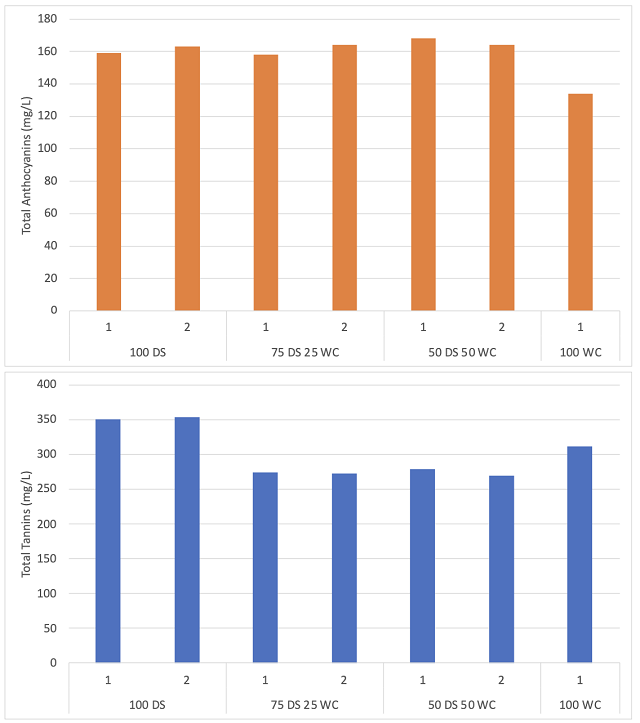
Figure 3: Mean descriptive scores for five attributes of three treatments of Syrah. Endcaps show significant differences.
